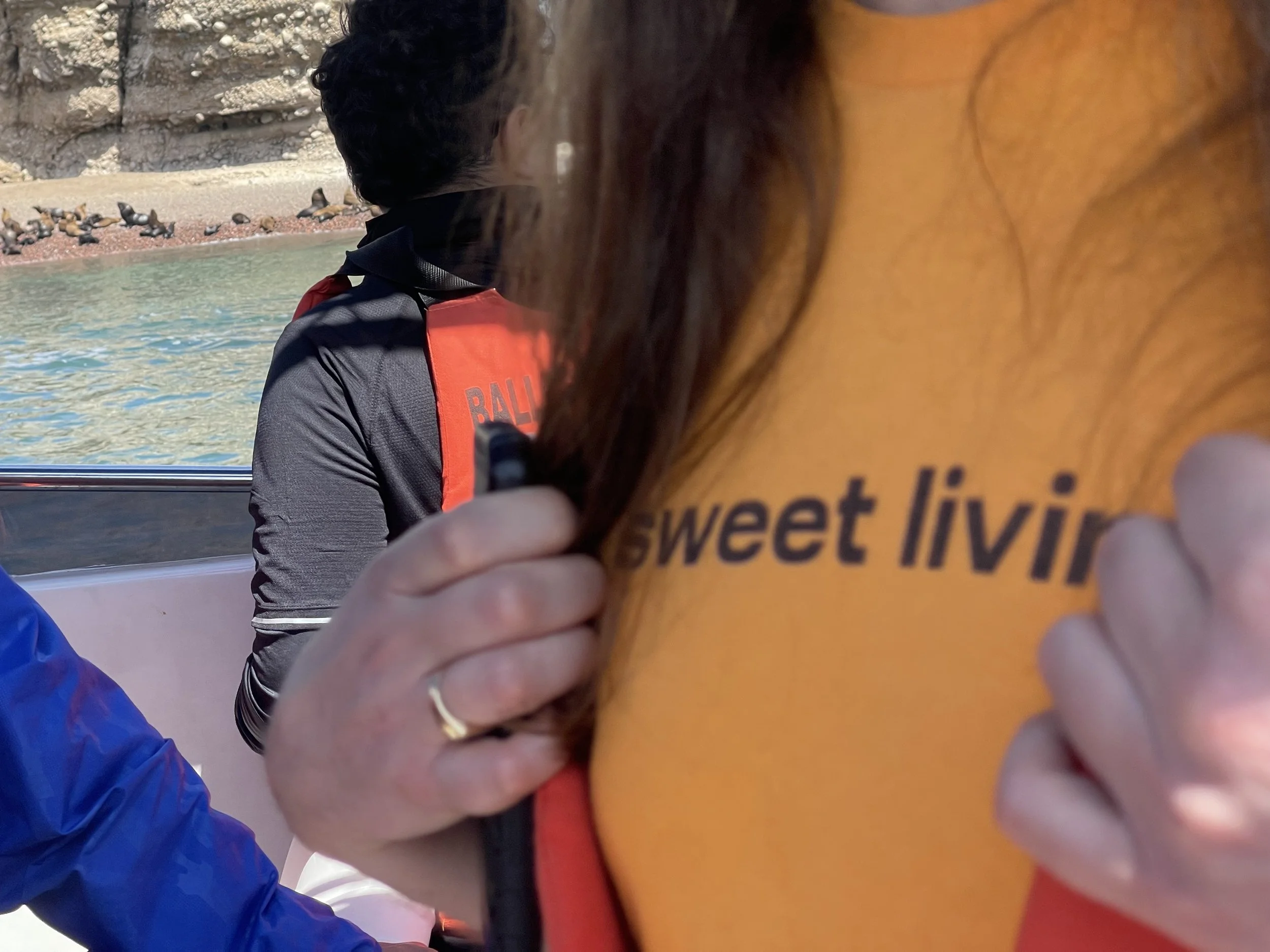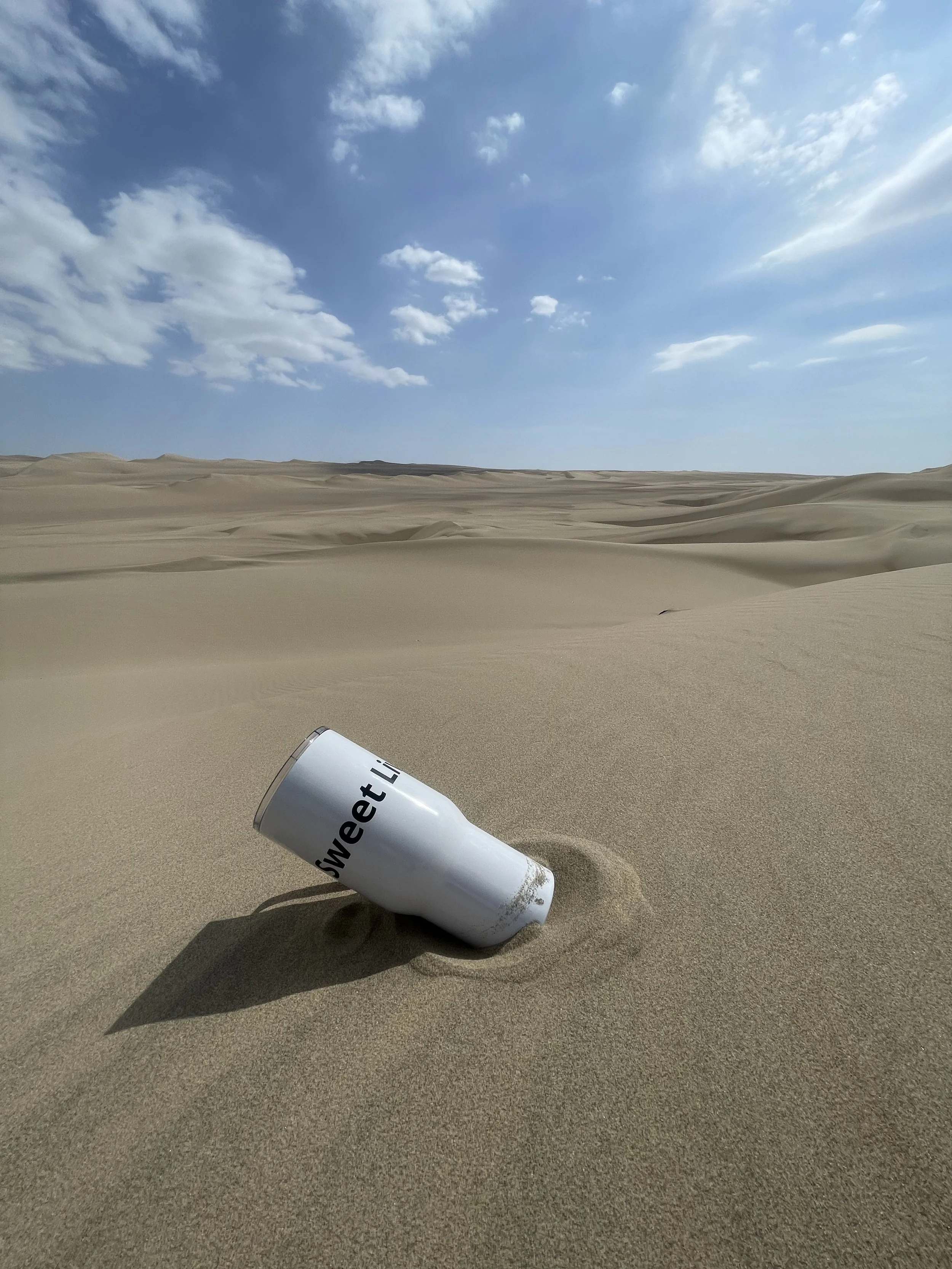Hammock Review:
Ica, Peru
Where did the sand on the couch come from? The guest wanted to know.
Though I am generally not a sand expert, as my background is not in arenology*, I knew it was Ica sand from the Ica Region of Peru.
How did I know the sand came from there?
A less educated reader than yourself may think it is because I reviewed sand there.
But no, that is not that case.
It is because I reviewed a hammock there.
But where exactly in the Ica Region was the sand from?
Well, my dear educated readers, let us now be educated further. As we will approach the above questions like the great scientific questions of old and delve into the sand science like the great arenologists of old through the lens of the greatest vision correctors** of old:
hammocks.
Yes, put on your metaphorical or figurative arenology hat and lie down in your very literal hammock—and read this Hammock Review, which seeks to answer those above sandy scientific questions for you.
And when your pushy parental figures—whether they be your actual parents or your partner or your boss—ask what you are doing with your time (as you lie so leisurely in the hammock), you can honestly tell them: science.
More specifically: arenology.
And they should not pester you further because they will probably not know what arenology is, and so it is likely they could feel ignorant.
Because they are ignorant.
Because they obviously didn’t take the time to enlighten themselves by reading this Enlightening & Respected Review like you did.
So rather than pander to them by telling them they aren’t ignorant, which they obviously are, simply share this Review with them, and solve the root problem of their ignorance. #GiveAManAFish…
So, like the great scientific studies of old that take a long time to get to the point, let us now look at the first possible place this sand on the couch of Ica origin could have come from.
Paracas
That was our first stop of the day in the Ica Region of Peru. We were blessed with a picturesque sunny day, with a bright blue sky. A perfect day for a walk on the beach, which Paracas does have: aptly named Playa Paracas.
But it was also perfect weather for anything, such as taking a boat and dipping back in time to see a Pre-Inca, pre-Christ geoglyph: the Trident, El Candelabro.
From 200 B.C.***
Or before.
Its exact age is a mystery.
But, from our diligent research, we have been able to calculate its approximate age:
old.
Yet, its meaning remains a mystery.
Some believe it was used for religious purposes.
Some believe it was used for navigational purposes.
It certainly is used as such in the modern era, as it navigated us (in typical circuitous hammock-finding fashion) to a hammock.
But how has it been able to stay there that long, thousands of years on that sandy hill?
How has it been able to do what could never been done by the great sandcastles of old made by the great child architects of old on the great beaches of old? Where those fortified structures could not stand the test of time, and thus made little kids cry as their great work was washed into the ocean by waves, how does El Candelabro instead stand the test of time and inspire gasps of awe instead of tears of sorrow. How does El Candelabro still exist?
Science.
It’s perfectly placed in a location that does not rain, and where the winds dare not swing by to blow out the light of El Candelabro.
Yes, the old saying is true: location, location, location.
Ubicación, ubicación, ubicación.
Or whatever they said in pre-Inca times for location, which may have been:
Hammock, Hammock, Hammock.
Though it may not have been. We have no dictionaries from that time, so it may be better to not assume that “hammock” meant “location.”
It may be better to assume that “hammock” meant “great location.”
Or maybe “hammock” meant “the perfect location to put an El Candelabro in the side of the mountain the will prevent it from eroding or fading away and inspire generations for millenia to come, all the way from the pre-Christ to post-Anti-Hammock area (AKA: the Beautiful Hammock Future, AKA: the Common Hammock Era).
But this Review is not a linguistics study, just as it is not a work of arenology (citation: not boring as fuck, This Review is not), so we will let the tenured linguistics tackle the meaning of the word “hammock” in the pre-Inca Era as we systemically move forward in our Hammock Review, answering other important question:
But how did they know to place El Candelabro there? How did they know that was the perfect spot? (The “hammock” spot****, if you will).
To me, that’s the most amazing mystery of it all*****.
Oh how interesting these marvels of ancient mysteries are.
We are so enveloped on our evolution as humans that we almost assume the existence of an ever-increasing collective knowledge like the existence of gravity, or some other basic force.
But there are certainly times when secret knowledge is lost. And it causes wonder. So much that we are inspired to produce History Channel shows about it.
And Hammock Reviews, where El Candelabro lights the way, for El Candelabro is indeed a prime example of ancient knowledge lost and thus blossoming into a seductive secret, a mystery.
A father reads a Hammock Review, which is a good thing, but fails to force his son to read the same Review, instead allowing him to read biology books on the way to med school.
That hammock knowledge is lost.
Until an archaeologist uncovers it years later.
And tourists flock to it and try to decipher its meaning.
And so we have a similar sort of situation with El Candelabro.
Evidently thousands of years ago in Paracas a man had two sons.
One went to the local medical school and later found the cure to cancer.
But failed to etch it on sand on the side of a hill.
Or did etch the cure in sand, but on the wrong hill—and so it blew away.
And now people die of cancer. #Incompetence
And the other son laid in hammocks all day and thus trained his brain to put a chandelier on the correct side of the hill so it would never blow away, and thus the chandelier burns bright with knowledge that could bring us all to enlightenment.
If we could just figure out the meaning.
If we could just imagine it.
This is what will be known, once a scribe copies it down from this internet page onto a piece of parchment and buries it in the ground in a location where it won’t be found for years but not too discreet where it would never found but is instead uncovered and readable: the Paracas Parable.
Now, as a humble Hammock Reviewer, I am humble enough to be like the star player who wins MVP of a championship team and then credits his teammates after rather than boasting about himself. As such, I know I am not wise enough to figure out the meaning of El Candelabro myself, to write the sequel to the Paracas Parable. But if I can encourage enough other people (i.e. teammates) to hang their hammock and lie in it long enough, one of them may imagine the meaning and write the Paracas Parable II.
Yes, dear Hammock Review readers, dear hammock-lier-iners, we are the protagonists in the great play that is the world. But unfortunately, for every story, for every chandelier, their is an asshole antagonist phantom trying to tear it down. #Jerk
So what do we do? How do we defeat these bad actors, these antagonists, these ghosts that haunt us, these phantoms around us?
We lie in hammocks, of course.
Please, Be Our Guest to lie in whatever hammock is hung nearby. And answer these great life questions. Or allow them to gently rock you to sleep.
El Candelabra,
A View From The Boat
Paracas Wildlife Living Hammock Lifestyle Sans Hammock #Don’tLetYourCircumstancesDictateYourMentalityOrMindset
Sweet Boardwalkin’
Sweet Livin’ Supermannin’
This Is Livin’: Sweet Livin’
Cerca De Cerro Prieto
AKA
Muy Cerca De Pisco
Next we stopped at a restaurant near Cerro Prieto. After a delicious meal, we had a delicious Pisco tasting.
Because no great section of a great Hammock Review ever started with someone eating a salad.
Yes, Pisco is like wine.
In that it is made from grapes.
Yet, it is like liquor in alcohol content.
In that it is liquor.
In that it is brandy.
Grape brandy.
And it flows from rivers.
Río Pisco to be precise.
And where the dumb and the dumber think Aspen is the destined land where beer flows like wine, it is the enlightened and enlighteneder of Hammock Review readers that realize it is Pisco—the port city in Ica—where people went to from all around the world to get their Pisco.
And so we went there too, sort of cerca de the city of Pisco, to taste Pisco.
And we were tested, like the great feats of strength of old, such as Scottish Stone Lifting, to see if we could properly imbibe the Pisco.
So the test was passed.
And what [should] have people done throughout history when they’ve passed a great test? When they’ve lifted a big stone, scored perfect on the SAT, won the Super Bowl, or done something else to impressive the woman of their dreams?
Rested in a hammock.
The Professional
(Boracho Profesional)
(Professional Hammock Review Writer)
(Person With Other Work Where People Pay Him Actual Recognized Currency In Exchange For Labor)
Damn, that’s a good-looking hammock.
Damn, that’s a good-looking hammock model.
Damn, that’s a good-looking Hammock Review writer.
And damn, that’s a lot of modesty. Authentically so. Because the educated among us (all of us reading or writing this Review), know that the hammock makes the model. So when we compliment the man in the hammock, we are really just complimenting the hammock itself. In this way, hammocks make vanity okay. Because when in a hammock, vanity is always modesty. That’s how Carly Simon was able to write a hit song about a hammock with its true subject remaining a mystery for so many decades.
Huacachina
After passing our professional job review with flying colors, it was time to move on to Huacachina.
Huacachina, like the great small towns of old in the great deserts of old, is build around a great oasis of old.
Oasis
Oasis Livin’
Oasis Thinkin’
How Was Thee Oasis Made?
It was created on the great myths of old. In this case, multiple myths.
One myth has that the oasis was built on the tears of grief. An Inca princess cried and cried for however long it takes to cry enough tears to create a lagoon.
But cold-hearted skeptical mirror executives who don’t believe a princess could cry sufficient tears to create a lake on sand lean heavily into a series of mirror-centric stories centering around a princess noticing a creepy hunter in her mirror as she is bathing. Creeped out that the hunter was approaching her rather than lying on a hammock on such a hot day, she fled and her mirror allegedly turned into a lagoon. And so now tourists bathe in the waters of vanity while mirror barrens reap the profits with every backstroke.
Another version, popular in Hammock Reviews, is that the princess was strolling around the desert and saw a hunter, whom she initially thought was a regular hunter of food. No big deal. Then, she realized, when he was cutting down her hammock that he was not a hunter of animals but rather a hunter of hammocks. He stole her royal hammock, which to this day has never been found, and so she cried so many tears that she created this oasis in the desert. She is now a mermaid in the lake, waiting for one of the many tourists that flock to Huacachina to find her hammock and return it to her so she can return to her princess state, marry the tourist that does that, and live happily ever after in The Beautiful Hammock Future, which at that point with be The Beautiful Hammock Present, with present being not a pun meaning both the current epoch and gift, but rather simply a word that meaning both of those things because everything will be a gift in The Beautiful Hammock Future and gifts will be indistinguishable from the present time in a way that will be hard—if not impossible—for humans to conceive reading this in any of the anti-hammock eras that preceded The Beautiful Hammock Future, just as it may be hard for humans living in anti-hammocks era to conceive a princess crying so many tears and turning into mermaid because some asshole stole her hammock.
But it is true.
We know this because, as proven above, vanity is only modestly in a hammock. And this great princess was modest. So of course, she left her mirror in her hammock, which is something the fat cat mirror execs fail to disclose when promoting the mirror-manic stories above. The mirror that was stolen was later obtained by a Carly Simon lover who always had “one eye in the mirror.”
With the establishment of Huacachina so incredibly established, we can now proceed to what proceeded post-establishment.
We, like the many present-day tourists, flocked there for fun and games in the sand dunes.
The main two activities are sandboarding and buggy freewheelin’. Some, like the Other Internet, commonly call the latter buggy tours.
But it’s not really a tour of the various sand dunes in the desert with a tour guide telling you the various heights of the various dunes.
That would be okay.
But not great.
Not Sweet Livin’.
And the buggy freewheelin’ in the desert is indeed Sweet Livin’.
I am not an adrenaline junkie by any means. But the buggying around the sand dunes was super Sweet Livin’. It was absolutely amazing. I recommend it to anyone.
While I’m sure renting your own would be fun as well—and I would like to try that sometime—having a “guide” or experienced driver was a lot of fun because they knew what to do to maximize the excitement. They did things that I would have never done for fear of rolling the buggy or getting in an accident. I’m not talking about taking chance; I just mean that through their experience and skill they were able to maximize the thrill of going down the hills and maneuvering in fun ways.
The sandboarding was okay. I mean it was fun, but nothing really in comparison to the buggy freewheelin’. I imagine the sandboarding could be a lot of fun if you did it a lot and became experienced at it.
In short, the fun level of it all may be largely based on the operator. Anyone can ride along in the buggy with an experienced operator. So that is the easier path towards super Sweet Livin’ in the dunes. But if you stayed there for awhile and became experienced on the board or buggy, then I’m sure either could be super Sweet Livin’.
And it was super Sweet Livin’.
Sweet Livin’ Sandboardin’
Sweet St. Patty’s Day Celebratin’
Another St. Patty Day with no snakes seen. The man deserves a toast, with a (poorly-framed in the lazy self) Guinness, at an Irish Hostel Bar in the town below.
A Much Sweeter (And Much Better-Framed) St. Patty’s Day Salute
A Winery On The Way Back
We went to a winery on the way back and tasted some wine. It was good, but not as good as the Pisco. When in Rome, do as the Romans; and when in Ica, drink Pisco.
Days Later, Back On The Couch
With sand. There was sand on the couch. As we were not in a beach house, the guest naturally wanted to know why there was sand on the couch.
It is because couches are inferior to hammocks, where sand simply falls through the cracks. But even with a hole-less hammock, you can simply flip it over and dump out the sand.
They never never incorporating such features into couches when designing them.
So as we get ever closer to the verdict, to the jury’s final decision on this Great Hammock in Ica, you can guess what side we are slouching to, what kind of starry sentence we will give it.
But where did the sand come from, the guest naturally wanted to know.
We believe it to Huacachinian sand.
From the desert.
Where a princess left behind an oasis in the sand.
The Sweet Oasis
*A field so rare even so word processors think you’re full of shit and underline it.
**for one needs not wear glasses, even if their prescription is of the highest strength, when they are napping in a hammock.
***which is roughly 2230 B.C.H.E. (Before the Common Hammock Era), which is scheduled to start at 2020 A.D.
****rather than calling the height of sexual pleasure the the Gräfenberg spot, as our modern, anti-hammock society has chosen to do, did they know more than we do and call that mysterious place in the vagina the H-spot, for Hammock spot? Probably yes. But that is another one for (safely tenured) linguistics to tackle.
*****sans the sandy mystery of this Review.













